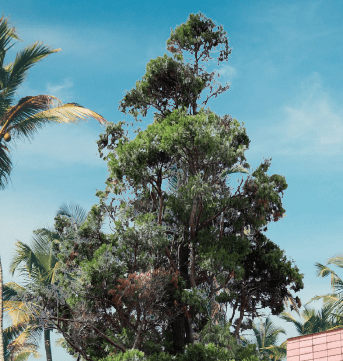The common name for Calocedrus decurrens is “Incense Cedar.” This tree is often referred to as incense cedar due to the pleasant cedar-like fragrance emitted by its wood and leaves when crushed or burned, making it popular for various aromatic and ornamental purposes.
Calocedrus decurrens, commonly known as Incense Cedar, is a coniferous tree native to the western United States. It is a species of cypress and is a member of the Cupressaceae family. Here are some key characteristics and information about Calocedrus decurrens:

- Distribution: Incense Cedar is primarily found in the mountainous regions of the western United States, including California, Oregon, and Nevada. It often grows in mixed conifer forests.
- Appearance: This tree can reach heights of 50 to 150 feet (15 to 45 meters) and has a straight, slender trunk. The foliage consists of scale-like leaves that are bright green and aromatic when crushed. The bark is reddish-brown, and the wood is durable and aromatic.
- Aroma: The name “Incense Cedar” is derived from the pleasant, cedar-like scent produced by the crushed foliage and wood. This aroma is often used in various cultural and traditional practices, including for incense and smudging.
- Timber: The wood of Calocedrus decurrens is highly valued for its durability and resistance to decay. It has been used in the construction of shingles, fences, furniture, and other outdoor applications. The wood is also used for making pencils.
- Cones: The tree produces small, round cones that are about 1/2 inch (1.3 cm) in diameter. These cones contain seeds and are a food source for various wildlife species.
- Ecological Significance: Incense Cedar is an important component of mixed conifer forests and provides habitat and food for various wildlife, including birds and mammals.
- Fire Adaptation: This tree species has adaptations that allow it to withstand wildfires, including thick bark that helps protect the cambium layer and allows for the tree to recover after a fire.
- Conservation Status: While Calocedrus decurrens is not listed as endangered or critically threatened, it is still subject to habitat loss and disturbances due to logging and land development.
- Ornamental Use: Incense Cedar is often planted for its aesthetic appeal in landscaping, parks, and gardens due to its attractive shape and fragrant foliage.
- Medicinal and Traditional Uses: As mentioned earlier, the aromatic properties of the wood and leaves have been used in various Native American and indigenous cultures for medicinal and ritual purposes, including as incense and for respiratory health.
Calocedrus decurrens is a unique and culturally significant tree in the western United States, appreciated for its ecological role, timber quality, and aromatic qualities. It plays a part in both natural ecosystems and human cultural practices.
What is the habit of calocedrus decurrens?
Calocedrus decurrens, the Incense Cedar, has a distinct growth habit characterized by the following features:
- Growth Form: It typically grows as a large, evergreen tree, which can reach heights ranging from 50 to 150 feet (15 to 45 meters).
- Shape: Incense Cedars have a conical or columnar shape, with a relatively narrow and straight trunk that tapers as it ascends. This shape gives the tree an attractive and symmetrical appearance.
- Foliage: The foliage consists of scale-like leaves arranged in flattened sprays. These leaves are bright green and have a pleasant, aromatic fragrance when crushed or disturbed.
- Bark: The bark of Calocedrus decurrens is reddish-brown and develops furrows and ridges with age.
- Branching: The branches are generally horizontal to ascending, and the tree maintains its conical shape as it matures.
- Cones: The tree produces small, round cones that are about 1/2 inch (1.3 cm) in diameter. The cones are often found on the upper branches and persist on the tree for some time.
- Roots: The root system of Incense Cedar typically consists of a deep taproot, which provides stability and access to water and nutrients, making it well-suited for its mountainous and often rocky habitat.
- Aromatic Qualities: As mentioned earlier, the tree has an aromatic quality, and its crushed foliage and wood emit a cedar-like scent, which is one of its notable features.
Overall, the growth habit of Calocedrus decurrens makes it an appealing tree for landscaping and ornamental purposes, as well as for its timber, aroma, and ecological significance in its natural habitat in the western United States.
